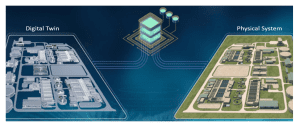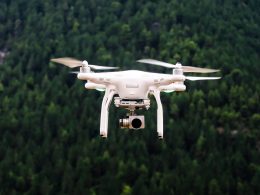Digital-twin technology has rapidly emerged as a transformative force, revolutionizing industries by providing an unprecedented level of insight and optimization. From improving supply chains to enhancing customer experiences, the impact of digital twins is profound. This article will delve into the benefits, applications, and real-world case studies that illustrate the technology’s potential.
What Is Digital-Twin Technology?
At its core, digital-twin technology refers to the creation of a virtual replica of a physical object, system, or process. This digital counterpart is connected to real-time data, allowing it to simulate behavior and conditions that mirror the real world. With the integration of sensors and IoT devices, digital twins can continuously update to reflect changes, offering a dynamic and real-time model that enhances decision-making processes.
Benefits of Digital-Twin Technology

Enhanced Decision-Making:
Digital twins provide businesses with real-time data and predictive insights. This means companies can run simulations and model various scenarios to make informed decisions. For example, manufacturers can identify potential equipment failures before they occur, reducing downtime and saving costs.
Operational Efficiency:
By modeling processes and testing them digitally, organizations can optimize workflows, reduce waste, and increase throughput. This capability has been especially beneficial in complex industries like aerospace and manufacturing.
Reduced Time to Market:
Product development benefits significantly from digital twins as companies can prototype, test, and iterate designs virtually. This reduces the time and cost associated with physical prototypes and accelerates the launch of new products.
Increased Agility and Resilience:
Digital twins help organizations respond faster to market changes and disruptions. For instance, supply chain digital twins can adapt to real-time data, enabling businesses to foresee and mitigate potential delays or disruptions.
Improved Customer Experience:
By creating customer digital twins, companies can analyze user behavior and preferences. This allows for personalized experiences and more effective marketing strategies.
Sustainability and Environmental Impact:
Digital twins contribute to sustainability by optimizing resource use and reducing waste. For example, they help in minimizing scrap during the production process, thereby supporting eco-friendly practices.
Real-World Examples of Digital-Twin Technology
1. Emirates Team New Zealand

One of the most compelling examples of digital-twin technology is Emirates Team New Zealand. By developing a digital twin of their sailing environment, the team was able to test thousands of hydrofoil designs virtually. This technology allowed them to optimize their boat designs without physically building each one, saving significant time and resources and contributing to their success in competitive sailing.
2. SpaceX
SpaceX has integrated digital-twin technology to create a virtual model of their Dragon capsule. This digital replica is used to monitor and adjust propulsion systems, trajectories, and loads. The result is improved safety and reliability during space missions, showcasing how digital twins can enhance complex engineering projects.
3. SoFi Stadium
SoFi Stadium utilizes a digital twin to aggregate data from various sources, including structural information and real-time football data. This comprehensive approach helps optimize stadium management and operations, ensuring a seamless experience for event attendees.
Case Studies Highlighting Digital-Twin Success
Anheuser-Busch InBev
Anheuser-Busch InBev (AB InBev), a global brewing company, has leveraged digital-twin technology to revolutionize its brewing and supply chain processes. The company developed a digital twin that models the brewing process and adjusts inputs based on real-time conditions. This allows AB InBev to automatically compensate for production issues, such as full vats or equipment bottlenecks, ensuring continuous and efficient production. The outcome has been a significant reduction in downtime and increased production efficiency.
Mercedes-Benz
Mercedes-Benz has taken customer experience to new heights by creating digital twins of their vehicles. Potential customers can interact with these digital models to “test drive” vehicles virtually. This immersive experience has helped the company boost sales and customer engagement, demonstrating the power of digital twins in enhancing top-line growth.
Types of Digital-Twin Technology
Digital twins come in various forms, each serving different purposes:
- Product Twins: These represent physical products and cover their entire lifecycle, from initial design to in-service operation. Product twins are essential for understanding product performance and identifying areas for improvement.
- Data Twins: A prime example is Google Maps, which functions as a digital twin of the Earth’s surface. Data twins use real-time information to optimize routes and help users navigate more efficiently.
- System Twins: These twins model interactions between different processes and components, such as manufacturing lines or supply chains. By simulating these interactions, businesses can identify inefficiencies and improve system performance.
- Infrastructure Twins: Infrastructure twins are used to represent large physical structures like buildings, stadiums, or bridges. These twins aid in maintenance, monitoring structural integrity, and ensuring safety.
How Digital Twins Enhance Supply Chain Management

Supply chain disruptions are a costly challenge for businesses. On average, such disruptions can impact up to 45% of a company’s cash profit in a year. To mitigate this risk, 86% of companies are investing in supply chain transformation—with digital twins ranking among the top three priorities.
A supply chain digital twin consolidates data from every aspect of operations to create a comprehensive model of the supply chain. This model enables leaders to:
- Run simulations: Test various supply-and-demand scenarios and see the potential impact on the supply chain.
- Optimize inventory: Track in-transit inventory and predict stock shortages or excesses.
- Enhance transparency: Meet regulatory requirements by providing upstream visibility into sourcing and manufacturing practices.
Companies that use supply chain digital twins have reported faster decision-making capabilities—up to 90% faster—and have experienced up to 20% improvements in customer delivery reliability.
Challenges in Implementing Digital-Twin Technology
Despite its benefits, implementing digital-twin technology comes with its challenges. Key obstacles include:
- Data Quality and Infrastructure: Digital twins rely heavily on high-quality data. Organizations need a robust data infrastructure capable of supporting continuous data flow from both live and testing environments.
- Change Management: Adopting digital twins requires a shift in company culture and operations. This change can be challenging without strong leadership and a clear strategy.
- Technical Expertise: Developing and maintaining digital twins require skilled professionals adept in IoT, AI, and data analytics. This may necessitate significant investments in talent acquisition and training.
The Future of Digital Twins and Generative AI
Generative AI (gen AI) is enhancing the capabilities of digital twins. Gen AI can streamline the development of digital twins by automating code creation, structuring data inputs, and synthesizing outputs. For example, large language models (LLMs) can assist developers in building digital-twin prototypes more efficiently. Additionally, digital twins provide a test-and-learn environment for gen AI, further amplifying their potential.
Sustainability Benefits of Digital Twins
Digital twins contribute significantly to sustainability initiatives. By optimizing product designs and reducing material waste, digital twins help companies minimize their environmental impact. For instance, manufacturers have reduced scrap waste by approximately 20% through the use of digital twins. Moreover, supply chain digital twins balance speed and cost with eco-friendly practices, ensuring sustainability throughout the entire process.
Conclusion
Digital-twin technology is not just a buzzword; it is a powerful tool driving innovation, efficiency, and sustainability across industries. From enhancing product development to fortifying supply chains, digital twins offer a competitive edge. With continuous advancements and integration with technologies like generative AI, digital twins are set to reshape how businesses operate and succeed in a rapidly changing world. Organizations that harness the power of digital twins today will be well-positioned to lead their industries tomorrow.












